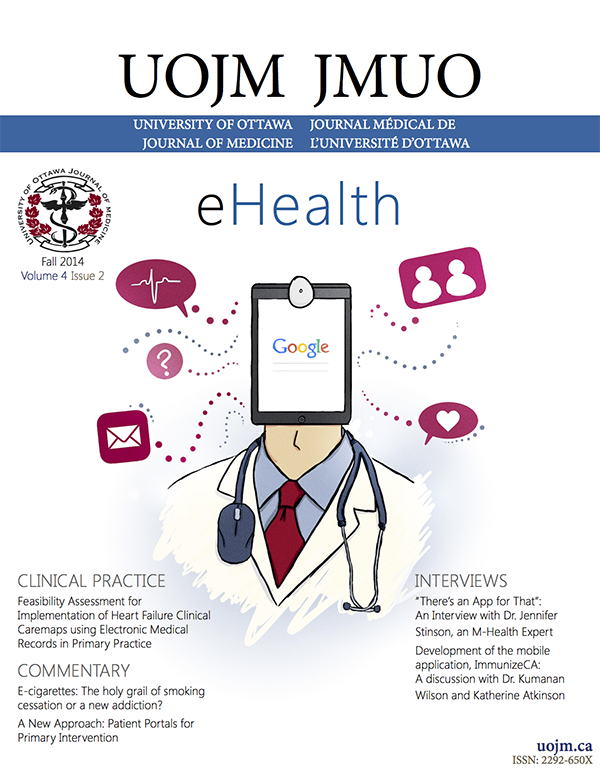A New Approach: Patient Portals for Primary Intervention
DOI:
https://doi.org/10.18192/uojm.v4i2.1051Abstract
N/AReferences
1. What is a patient portal? [Internet]. Washington, D.C., U.S. Department of Health and Human Services; [cited 2014 May 08]. Available from: http://www.healthit.gov/providers-professionals/faqs/what-patient-portal.
2. Hesse BW, Nelson DE, Kreps GL et al. Trust and sources of health information: the impact of the Internet and its implications for health care providers: findings from the first Health Information National Trends Survey. Arch Intern Med 2005; 165: 2618–2624.
3. Johnson CM and Shaw R. Health Information Seeking and Social Media Use on the Internet among People with Diabetes. Online J Public Health Inform 2011; Vol.3: No. 1.
4. Newcomb C and Tang P. A Guide for Providing Patient Health Information. J Am Med Inform Assoc. 1998;5:563-570.
5. Cunningham TD, Johnson RE, Krist AH et al. Interactive preventive health record to enhance delivery of recommended care: a randomized trial. Ann Fam Med. 2012;10:312-319.
6. Borrachero C, Marin Y, Pujol E et al. Illegible handwriting in medical records. J R Soc Med. 2002;95:545–546.
7. Wireless Smart Gluco-Monitoring System [internet]. iHealth Lab Inc. 2012 [cited 2014 May 08]. Available from http://www.ihealthlabs.com/wireless-smart-glucose-monitoring-system-bg5.htm.
8. Burge MR. Lack of Compliance With Home Blood Glucose Monitoring Predicts Hospitalization in Diabetes. Diabetes Care. 2001; 24: 1502-1503.
2. Hesse BW, Nelson DE, Kreps GL et al. Trust and sources of health information: the impact of the Internet and its implications for health care providers: findings from the first Health Information National Trends Survey. Arch Intern Med 2005; 165: 2618–2624.
3. Johnson CM and Shaw R. Health Information Seeking and Social Media Use on the Internet among People with Diabetes. Online J Public Health Inform 2011; Vol.3: No. 1.
4. Newcomb C and Tang P. A Guide for Providing Patient Health Information. J Am Med Inform Assoc. 1998;5:563-570.
5. Cunningham TD, Johnson RE, Krist AH et al. Interactive preventive health record to enhance delivery of recommended care: a randomized trial. Ann Fam Med. 2012;10:312-319.
6. Borrachero C, Marin Y, Pujol E et al. Illegible handwriting in medical records. J R Soc Med. 2002;95:545–546.
7. Wireless Smart Gluco-Monitoring System [internet]. iHealth Lab Inc. 2012 [cited 2014 May 08]. Available from http://www.ihealthlabs.com/wireless-smart-glucose-monitoring-system-bg5.htm.
8. Burge MR. Lack of Compliance With Home Blood Glucose Monitoring Predicts Hospitalization in Diabetes. Diabetes Care. 2001; 24: 1502-1503.
Downloads
Published
2014-11-17
Issue
Section
Commentary
License
- Authors publishing in the UOJM retain copyright of their articles, including all the drafts and the final published version in the journal.
- While UOJM does not retain any rights to the articles submitted, by agreeing to publish in UOJM, authors are granting the journal right of first publication and distribution rights of their articles.
- Authors are free to submit their works to other publications, including journals, institutional repositories or books, with an acknowledgment of its initial publication in UOJM.
- Copies of UOJM are distributed both in print and online, and all materials will be publicly available online. The journal holds no legal responsibility as to how these materials will be used by the public.
- Please ensure that all authors, co-authors and investigators have read and agree to these terms.
- Works are licensed under a Creative Commons Attribution-NonCommercial-NoDerivatives 4.0 International License.


